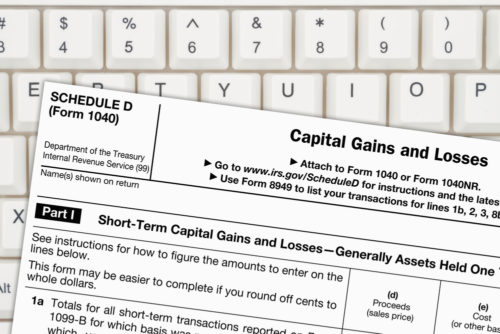Capital gains tax is a tax on the difference between the price at which you purchase an asset or investment and the price at which you sell it. You realize capital gains when there is a positive difference between the buying and selling price.
If you experience a loss (the sales price is less than the purchase price), the transaction may still affect your tax bill. Also, in practice, capital gains get influenced by commissions and fees associated with buying and selling. In the case of investment real estate or other tangible property, the cost of improvement could also count against capital gains.
Table of Contents
What Are Capital Gains?
Capital gains are profits made from the sale of an asset. Often, people associate the term “capital gains” with the sale of assets like stocks and bonds. However, capital gains can include investment income from real estate, vehicles, or other personal property.
Other items that may realize capital gains include collectibles, art, jewelry, precious metals, and antiques.
There are notable exceptions. For example, business inventory and depreciable business property do not qualify for capital gains. Neither do certain intangible assets such as copyrights, patents, inventions, and designs.
According to tax rules, the length of time that you hold a capital asset before selling it can be significant. No matter how much your stocks or property appreciates, as long as you haven’t sold these assets, you do not have to pay capital gains tax on them.
Do Capital Gains Count As Income?
With some exceptions, capital gains get treated as a form of income. However, the type of income may vary depending on the kind of asset or investment and the length of time that you own it.
In most cases, how long you hang on to capital gains determines the rate at which they’re taxed. If you have a stock or bond for more than one year, then you have to pay long-term capital gains taxes. If you keep an asset for less than one year, it gets treated as a short-term capital gain, and it gets taxed at a higher rate than long-term gains.
An example of long-term capital gains would be shares of a company that you bought for $5,000. If you sold them two years later for $6,000, your capital gain would be $1,000 (minus any fees you paid to a broker during buying and selling). Since you held the stock for more than one year, you would pay a long term capital gains tax on $1,000. Depending on your income bracket, your tax rate could be 0%, 15%, or 20%.
Short-term capital gains have the same tax rate as regular income, so they depend on your tax bracket. In general, short-term capital gains levies are higher than long-term capital gains taxes.
If you purchase shares of stock for a total of $5,000 and sell them for $6,000 two months later, your short-term capital gains amount to $1,000. The short-term capital gains tax would be 10%, 12%, 22%, 24%, 32%, 35%, or 37%, depending on your income tax bracket. In other words, short term gains get treated like regular income.
Capital gains taxes may be different for real estate if the property is a primary residence. If you lived in the home (and can prove it is a primary residence) for at least two years, you qualify for an exemption from capital gains taxes when you sell the home. The exemption is on the first $250,000 in capital gains if you are single or filing separately and $500,000 in capital gains if you are married, filing jointly.
For example, if you purchased a home as your primary residence for $200,000 and sold it two years later for $300,000, your capital gains would be $100,000. However, since you held the house for the required amount of time, and the capital gains were under the exemption amount, you do not have to pay capital gains taxes.
Short-Term Capital Gains Tax
Short-term capital gains taxes are on the profits from the sale of investments or assets that you hold for less than one year. The IRS treats these profits as regular income and taxes them at the same rate. One thing to consider is that short-term gains could put you into a different tax bracket when combined with your regular income.
Long-Term Capital Gains Tax
Long term capital gains are on profits for the sale of assets that you’ve held for longer than one year. The amount of tax you have to pay depends on a simplified income tax bracket. Currently, there are three levels for capital gains taxes: 0%, 15%, and 20%. These levels are different depending on your filing status.
Capital Gains Tax Rates
The tax rate for long-term capital gains is as follows:
| Single | Married, filing separately | Married, filing jointly | Head of Household | |
| 0% | $0 to $39,375 | $0 to $39,375 | $0 to $78,750 | $0 to $52,750 |
| 15% | $39,376 to $435,550 | $39,376 to $244,425 | $78,751 to $488,850 | $52,751 to $461,700 |
| 20% | $434,551 and up | $244,426 and up | $488,851 and up | $461,701 and up |
For short-term capital gains, the income brackets and tax rates are as follows. These rates can change slightly from year to year.
| Single | Married, filing separately | Married, filing jointly | Head of household | |
| 10% | $0 to $9,700 | $0 to $9,700 | $0 to $19,400 | $0 to $13,850 |
| 12% | $9,701 to $39,475 | $9,701 to $39,475 | $19,401 to $78,950 | $13,851 to $52,850 |
| 22% | $39,476 to $84,200 | $39,476 to $84,200 | $78,951 to $168,400 | $52,851 to $84,200 |
| 24% | $84,201 to $160,725 | $84,201 to $160,725 | $168,401 to $321,450 | $84,201 to $160,700 |
| 32% | $160,726 to $204,100 | $160,726 to $204,100 | $321,451 to $408,200 | $160,701 to $204,100 |
| 35% | $204,101 to $510,300 | $204,101 to $306,175 | $408,201 to $612,350 | $204,101 to $510,300 |
| 37% | $510,300 and up | $306,176 and up | $612,351 and up | $510,301 and up |
How Capital Gains Are Calculated
Capital gains taxes get applied to stocks, bonds, real estate, cars, boats, and other forms of property and investment.
To calculate capital gains taxes, you need to take three steps.
- You start by calculating the basis. The basis is the price you pay for an asset such as a stock or an investment property. You include any fees or commission payments.
- You then calculate the sale price and subtract any fees and commissions from this amount.
- The capital gain is the sale price minus the basis (with commissions and fees included on each side of the equation).
You can use the same equation to calculate capital losses. If the sale price is lower than the basis, then the answer is a negative number. While calculating your overall capital gains, or net capital gains, for the tax year, you subtract the capital losses from capital gains. The net capital gain is the amount that you use to calculate capital gains taxes.
Finally, add your capital gains to your other income to find out which tax bracket you belong to.
How to Minimize Capital Gains Taxes
Make sure you understand the rules and exceptions for capital gains. These can help you avoid paying more capital gains tax than you need.
You should also be aware of income thresholds. If your capital gains move you into a higher tax bracket, your taxes could be much higher. For example, a single filer with an income of $39,470 pays 12% of it in taxes. However, if you sell a stock during the tax year for just $100 in capital gains, your income moves to $39,570, which puts you in the 22% tax bracket.
- Hold onto assets for more than a year: Holding assets such as real estate or stocks for more than one year can result in long-term capital gains taxes, which have a lower rate than short-term gains taxes.
- Exclude home sales: You can exclude income from the sale of your primary residence. Up to $500,000 in profits could be exempt from capital gains taxes (or up to $250,000 in profits for single filers).
- Rebalance dividends with investments: You can reinvest dividends from high-performing stocks to avoid having to pay capital gains taxes from selling the stock.
- Use tax-advantaged accounts: You may also use tax-advantaged accounts such as an IRA or Roth IRA. You can invest funds inside these accounts without exposing yourself to capital gains taxes. In most cases, you cannot access these funds until you retire.
- Carry capital losses over: If you have reached the maximum amount of capital gains allowed during a tax year, consider carrying your losses over to the next year so that you can use them to lower your net capital gains.
Image Source: https://depositphotos.com/





